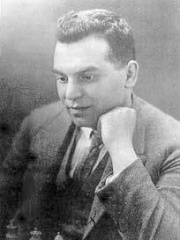
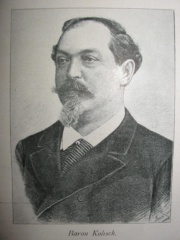
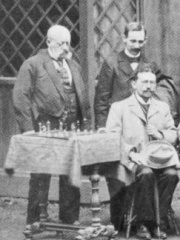

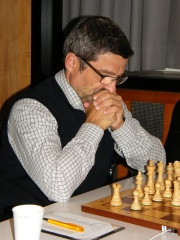
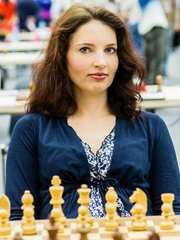
The Most Famous
CHESS PLAYERS from Slovakia
This page contains a list of the greatest Slovak Chess Players. The pantheon dataset contains 461 Chess Players, 7 of which were born in Slovakia. This makes Slovakia the birth place of the 20th most number of Chess Players behind Spain, and Bulgaria.
Top 7
The following people are considered by Pantheon to be the most legendary Slovak Chess Players of all time. This list of famous Slovak Chess Players is sorted by HPI (Historical Popularity Index), a metric that aggregates information on a biography's online popularity.

1. Richard Réti (1889 - 1929)
With an HPI of 66.65, Richard Réti is the most famous Slovak Chess Player. His biography has been translated into 36 different languages on wikipedia.
Richard Réti (28 May 1889 – 6 June 1929) was an Austro-Hungarian and later Czechoslovak chess player, chess author and composer of endgame studies. He was one of the principal proponents of hypermodernism in chess. With the exception of Nimzowitsch's book My System, he is considered to be the movement's foremost literary contributor.

2. Ignatz Kolisch (1837 - 1889)
With an HPI of 58.22, Ignatz Kolisch is the 2nd most famous Slovak Chess Player. His biography has been translated into 18 different languages.
Baron Ignatz von Kolisch (6 April 1837 – 30 April 1889), also Baron Ignaz von Kolisch (German) or báró Kolisch Ignác (Hungarian), was a merchant, journalist and chess master with Jewish roots.

3. Adolf Schwarz (1836 - 1910)
With an HPI of 53.77, Adolf Schwarz is the 3rd most famous Slovak Chess Player. His biography has been translated into 15 different languages.
Adolf Schwarz (31 October 1836, Gálszécs, Hungary, now Sečovce, Slovakia – 25 October 1910, Vienna) was an Austro-Hungarian chess master. He took 10th in the Vienna 1873 chess tournament (Wilhelm Steinitz and Joseph Henry Blackburne won). In 1878, he took 2nd, behind Louis Paulsen, in Frankfurt. In 1879, he took 3rd in Leipzig (1st DSB-Congress, Berthold Englisch won). In 1880, he tied for 1st–3rd with Blackburne and Englisch in Wiesbaden. In 1880, he tied for 1st–3rd with Max Weiss and Johannes Minckwitz in Graz. In 1880, he tied for 3rd–5th in Braunschweig. In 1882, he took 3rd in Vienna (Vincenz Hruby won), and tied for 12–13th in the Vienna 1882 chess tournament (Wilhelm Steinitz and Szymon Winawer won). Adolf Schwarz won matches against Minkwitz (+3 -2 =4) in 1878, and against Winawer (+3 -1 =0) in 1880.

4. Max Weiss (1857 - 1927)
With an HPI of 53.37, Max Weiss is the 4th most famous Slovak Chess Player. His biography has been translated into 15 different languages.
Miksa Weisz (21 July 1857 – 14 March 1927), better known as Max Weiss, was an Austrian chess player born in the Kingdom of Hungary. Weiss was born in Sereď. Moving to Vienna, he studied mathematics and physics at the university, and later taught those subjects. Weiss learned to play chess at age 12, and his strength increased steadily throughout the 1880s. 1880, Graz, tied with Adolf Schwarz and Johannes Minckwitz for first prize. 1882, Vienna, tenth, won two games from Johann Zukertort, and drew with Wilhelm Steinitz. 1883, Nuremberg, tenth. 1885, Hamburg, tied with Berthold Englisch and Siegbert Tarrasch for second prize. 1887, Frankfort-on-the-Main, divided second and third prizes with Joseph Henry Blackburne. 1888, Bradford, tied with Blackburne for sixth prize. 1889, New York, (the sixth American Chess Congress), scored +24−4=10 to tie with Mikhail Chigorin for first prize, ahead of Isidor Gunsberg and Blackburne. 1889, Breslau, third prize. 1890, Vienna, first prize, ahead of Johann Bauer and Englisch. The New York 1889 tournament was organized to find a challenger for the World Chess Championship, but neither Chigorin (who had already lost a championship match) nor Weiss pursued a title match with Steinitz. In fact, having become one of the top players in the world, Weiss quit international chess after this tournament, though he did play a few Viennese events. In 1895 he defeated Georg Marco in a match, +5 −1 =1, and he tied for first in the 1895–6 winter tournament with Carl Schlechter. Around this time, Weiss began working to create a Viennese school of chess players. In 1905 Weiss was employed by S M von Rothschild bank in Vienna. His chess writings, Schachmeister-Streiche (Mühlhausen 1918), Kleines Schachlehrbuch (Mühlhausen 1920), and the earlier problem collection Caissa Bambergensis (Bamberg 1902), are little remembered today. In 1927 Weiss died in Vienna, Austria.

5. Herman Steiner (1905 - 1955)
With an HPI of 52.58, Herman Steiner is the 5th most famous Slovak Chess Player. His biography has been translated into 16 different languages.
Herman Steiner (April 15, 1905 – November 25, 1955) was an American chess player, organizer, and columnist. He won the U.S. Chess Championship in 1948 and became International Master in 1950. Even more important than his playing career were his efforts promoting chess in the U.S., particularly on the West Coast. An exemplar of the Romantic School of chess, Steiner was a successor to the American chess tradition of Paul Morphy, Harry Nelson Pillsbury, and Frank Marshall.

6. Ľubomír Ftáčnik (b. 1957)
With an HPI of 52.41, Ľubomír Ftáčnik is the 6th most famous Slovak Chess Player. His biography has been translated into 17 different languages.
Ľubomír Ftáčnik (born October 30, 1957, in Bratislava) is a Slovak chess grandmaster and a former European Junior Champion.

7. Eva Repková (b. 1975)
With an HPI of 38.67, Eva Repková is the 7th most famous Slovak Chess Player. Her biography has been translated into 14 different languages.
Eva Repková (born 16 January 1975 in Stará Ľubovňa) is a Slovak chess player holding the FIDE titles of International Master (IM) and Woman Grandmaster (WGM). She was Czechoslovak Women's Champion in 1991 and Slovak Women's Champion in 2003, 2010 and 2013.
People
Pantheon has 7 people classified as Slovak chess players born between 1836 and 1975. Of these 7, 2 (28.57%) of them are still alive today. The most famous living Slovak chess players include Ľubomír Ftáčnik, and Eva Repková. The most famous deceased Slovak chess players include Richard Réti, Ignatz Kolisch, and Adolf Schwarz. As of April 2024, 1 new Slovak chess players have been added to Pantheon including Eva Repková.
Living Slovak Chess Players
Go to all RankingsDeceased Slovak Chess Players
Go to all RankingsRichard Réti
1889 - 1929
HPI: 66.65
Ignatz Kolisch
1837 - 1889
HPI: 58.22
Adolf Schwarz
1836 - 1910
HPI: 53.77
Max Weiss
1857 - 1927
HPI: 53.37
Herman Steiner
1905 - 1955
HPI: 52.58
Newly Added Slovak Chess Players (2025)
Go to all RankingsOverlapping Lives
Which Chess Players were alive at the same time? This visualization shows the lifespans of the 5 most globally memorable Chess Players since 1700.

